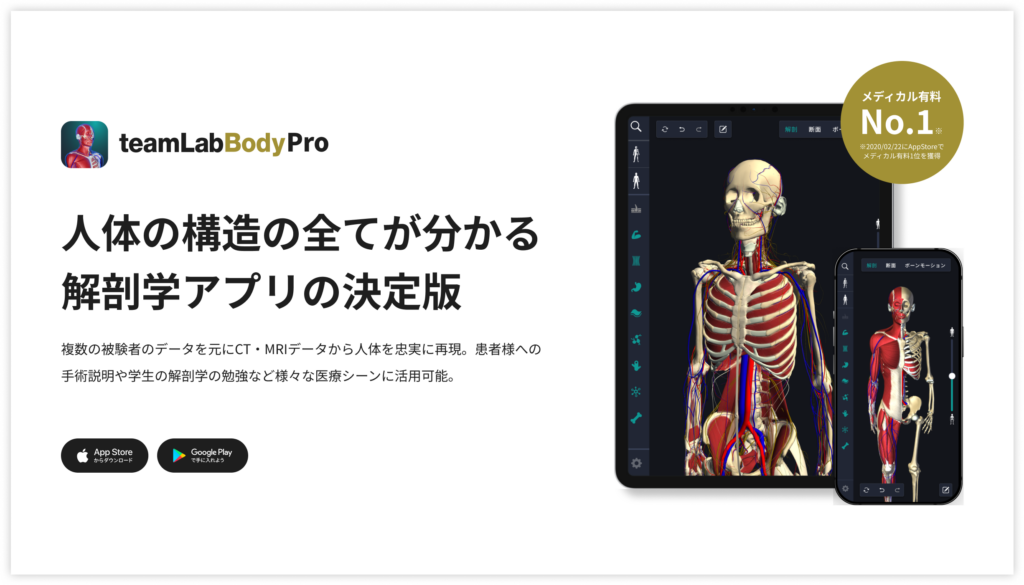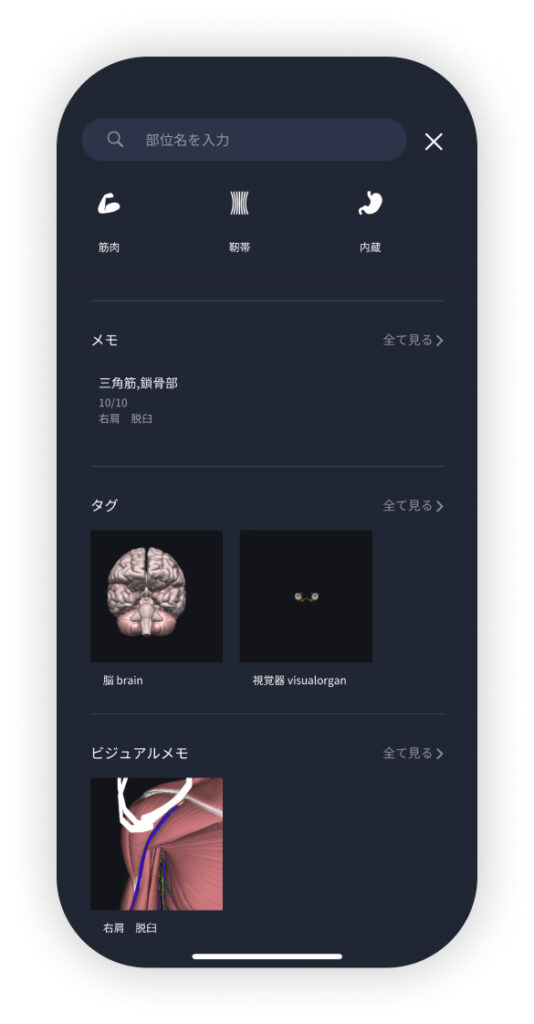beginning
In this article, I will explain effective study methods, starting with knowledge of specialized parts in human anatomy.
In human anatomy, it is necessary not only to memorize the names of various organs, muscles, and bones, but also to remember where they are located in the body. Therefore, it is necessary to learn as efficiently as possible.
I hope you will deepen your understanding even a little by reading this article and using the app.
Now, I will explain the contents of the “scalene muscle (front/medium/back)” and how to study human anatomy.
teamLab Body Pro Free Download
A 3D anatomy app that shows all the structures of the human body
Download teamLab Body Pro here!

What is scalene muscle (anterior/medium/posterior)?
The anatomy application allows you to view a selection of anatomy 3D models. In this model, there are various observation methods such as surfaces, cross-sections, and nervous systems. This time, I'll explain using an anatomy application.
About scalene muscle (anterior/medium/posterior)

The scalene muscle group (scalene muscles) consists of three muscles: anterior scalene (anterior scalene), middle scalene (middle scalene), and posterior scalene (posterior scalene), all of which are deep muscles that run from the cervical spine to the ribs.
These muscles also work as breathing support muscles, and help expand the rib cage by pulling up the 1st and 2nd ribs during inhalation. It is also involved in lateral bending and rotation of the neck, and plays an important role in everyday movements.

Brachial plexus and subclavian artery pass between anterior scalene muscle and median scalene muscle, and this structural relationship is also regarded as clinically important. In particular, it is essential for understanding conditions involving nerve and vascular strangulation, such as “scalene syndrome.” These muscles are very important points in understanding the cooperation between the neck and upper limbs.
The middle scalene muscle (middle scalene) is the largest muscle in the scalene muscle group and plays a central role. The beginning is the lateral projection of the 2nd to 7th cervical vertebrae, and the stop is on the upper surface of the 1st rib, just behind the anterior scalene muscle. In addition to neck side bending movements, this muscle works as a “breathing aid muscle” to assist in thorax expansion by pulling up the first rib during inhalation. The anterior scalene muscle is located in front of the medial scalene muscle, and between these 2 muscles (scalene gap)brachial plexuswithsubclavian arterywill pass through.

The posterior scalene muscle (posterior scalene) is the most posterior-located deep muscle in the scalene muscle group. It usually starts at the lateral protrusion of the 4th to 6th cervical vertebrae and stops on the outer side of the 2nd rib. Abdominal muscles are slender, smaller and less noticeable than anterior scalene muscles and medial scalene muscles, but they are functionally important.
The main effect is to help the neck to bend laterally (tilt to the same side), and to assist in the expansion of the rib cage by pulling up the second rib during inhalation. Therefore, it is also classified as one of the respiratory support muscles.
Also, since the posterior scalene muscle is part of the deep structure of the neck, and cervical nerves and blood vessels are distributed around it, anatomical understanding is also important clinically. Anatomically, it is more difficult to grasp position compared to anterior/median scalene muscle, so a three-dimensional perspective is required for learning.
Study points
Anatomical understanding: accurately capture structure and positional relationships
The scalene muscle group is a deep muscle underneath the superficial muscles and runs from the cervical spine to the ribs. First, it's basic to memorize the starting and stopping parts of each muscle. In particular, the brachial plexus and subclavian artery pass through the “scalene gap” that passes between the anterior scalene muscle and the median scalene muscle, so this is a clinically important point.
The use of 3D anatomy apps and human models is effective for learning. By visually checking muscle overlap and adjacent structures, the understanding of the structure deepens. Additionally, it is a good idea to keep track of skeletal relationships and positional relationships with other muscle groups (sternocleidomastoid muscle, levator scapula muscle, etc.) as a set.
Functional understanding: learning in relation to movement
In addition to lateral bending and rotation of the neck, the scalene muscle group is also involved in raising the rib cage during inhalation. In learning, you can understand muscle function experientially by actually tilting your neck to the side or taking a deep breath and feeling your shoulders rise slightly.
In particular, its role as a breathing aid muscle is often overlooked, so if you learn it in connection with “the reason why breathing becomes shallow when posture deteriorates,” it will be easier to remain in your memory. Also, by consciously moving either the left or right scalene muscle, it is easier to realize which muscle is involved in which movement.
Practical application: deepening from clinical relationships
The scalene muscle group also appears frequently in clinical settings. What is particularly famous is scalene syndrome (Thoracic Outlet Syndrome type 1), which occurs when nerves and blood vessels are strangled by the scalene muscle gap. Since it can cause numbness in the arms, shoulders, and hands, and impaired blood flow, understanding the scalene muscle and surrounding structures is essential.
When learning about these pathologies, a more practical understanding progresses by having the viewpoint of “what kind of structure is in the surroundings” and “what kind of compression can occur” rather than muscles alone.
How to study human anatomy
I will explain specific study methods using human anatomy applications.
Check your past learning history and practice repeatedly
Here are the steps to check your anatomy learning history and practice iteratively effectively.
1. Check your learning history in the app
Reviewing your learning history with the application is an important step in effectively advancing anatomy learning. First, launch the app and go to the learning history section from the main menu. Many anatomy apps are designed to show your progress in the form of graphs and lists, so you can visually check which parts you've learned about and how much time you've spent.
By using this data, you can understand which areas you have strengths in and where you need to spend more time and effort. We also recommend using a dedicated tag or notebook function to mark areas you are particularly weak at or where you need to relearn. Regularly checking your learning history and looking back on past learning content will lead to efficient review and deepening understanding.
2.Make a plan for iterative learning
Making an efficient repetitive learning plan based on learning history is extremely effective in promoting knowledge retention. First, identify weak points and areas where you need to relearn. Next, arrange these study items into a weekly or monthly calendar and create a specific study schedule. By proceeding in a planned manner, you can learn each part evenly and avoid packing in a large amount of information at once.
Using a task management app or digital calendar to set study reminders is effective. Also, it's important to have the flexibility to regularly review progress and revise plans as needed. By having goals and proceeding with your studies in a planned manner, you can efficiently acquire anatomical knowledge.
3.Use 3D features to learn visually
By utilizing the 3D function, learning anatomy is easier to understand visually. The 3D model shows the structure of the human body three-dimensionally, and each part can be observed in detail. This makes it possible to intuitively grasp positional relationships between deep muscles and organs that are difficult to capture in a planar view. For example, you can learn even the smallest details by rotating specific muscles and bones and zooming in and out.
Also, there are many apps that have the function of displaying cross-sectional views of each part using a 3D model, which is useful for deepening understanding of internal structures. This diversity of visual information helps with memory retention and improves immediate responsiveness in tests and practice situations. By utilizing the 3D function and learning visually, you can learn anatomy knowledge more deeply and efficiently.
Use the memo function concretely

Make notes so you don't forget the things and points you've noticed while studying. The memo function can be used for different purposes, such as inputting text, saving images, and writing memos. Tag your notes to make them easier to review later.
Test your learning regularly in the form of quizzes
Regularly testing what you've learned in a quiz format is a very effective way to anchor your anatomy knowledge. Quiz-style tests help you objectively grasp your level of understanding and areas you lack while repeating knowledge.
For example, by using a learning app to conduct quizzes every specific period, you can reconfirm what you've learned and strengthen your memory. There are a wide range of quiz formats, such as multiple choice questions, fill-in-the-blank questions, and short answer questions, and each helps understanding from a different angle and develops the ability to utilize various types of knowledge.
Get feedback
If possible, get feedback from other learners and experts. It helps you find your own gaps in understanding and areas for improvement. You can also keep yourself motivated to learn by regularly testing yourself. Feeling a sense of accomplishment and progress increases motivation for continuous learning.
summary
This time, I explained how to study “scalene muscle (front/medium/back)” using an application!
Thank you for reading this far.
I would be happy if reading this article helped you learn about anatomy.
Learning is a long, never-ending journey, but I sincerely wish you all the best. Let's continue to study together and work hard for the national exam!
Please look forward to the next blog.
teamLab Body Pro Free Download
A 3D anatomy app that shows all the structures of the human body
Download teamLab Body Pro here!





